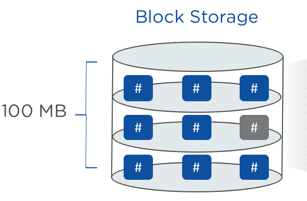

Block storage is also more complex than file storage and sometimes even requires that admins have special training or experience to work with it. The tradeoffs for block storage are that it can be more costly because storage-attached networks (SANs) can get expensive to buy and manage.

Incremental change ability – while file storage requires you to alter an entire file when making changes, block storage allows you to make incremental changes to specific blocks by replacing, inserting, or deleting them.In addition to the increased speed and performance of block storage, other benefits include: That makes block storage very efficient because data can take up almost the entire capacity, instead of having to make room for storing metadata.īecause of its speed, organizations use block storage when they need fast scale-up and speedy read/write performance. Part of what makes block storage so fast is that it doesn’t use any metadata except for the unique identifier for each block. When an application needs a file, it sends a request to the block storage system and the system gathers up all the relevant blocks quickly and efficiently, then assembles them into the complete file. That doesn’t slow down access, however, because each block has a unique identifier to distinguish it from every other block. The blocks aren’t organized hierarchically-in fact, they’re placed on the storage device in random order. RELATED Transform File Storage with Nutanix Files What Is Block Storage?Īs the name suggests, block storage breaks up information and stores it in blocks that contain anywhere from 256 KB to 4 MB of data. You can store data in file-level hierarchies in the cloud, which servers, applications, and employees can access easily and quickly. Today, cloud-based file storage is also an option. Backup/recovery – storing backup data on LAN devices allows you to recover quickly if your network goes down.Cost-efficient (to a point) – using a NAS device, you can remove data from expensive servers and store it on less costly LAN-connected devices.Familiar protocols – file storage relies on common protocols used throughout computing, such as Network File System (NFS), Common Internet File System (CIFS), and Server Message Block (SMB).Shared files – centralized storage on a local area network (LAN) makes it easy for anyone to access the stored data.Simplicity – familiar to computer users, straightforward, easy access to information provided you know the path.Drilling down to each file can be quick and simple until you have tens of millions of files saved in thousands of directories across hundreds of storage devices. With too much data, however, file storage gets not only expensive but unwieldy and time-consuming.

As data volumes expand, scaling file storage requires the addition of new hardware devices, or the replacement of existing ones with higher capacity devices. Business Continuity & Disaster RecoveryĬ: > Documents > Personal Taxes > 2022 > 2022_1040.pdfįile storage is best suited to unstructured data that is easy to categorize.It seems the HCI replacement of SANs is not happening. Just over 40 percent used SANs, and 25.5 percent used HCI, with a third using neither. We compared server SAN (HCI or hyperconverged infrastructure) use with actual SAN usage. On-prem files are increasing faster than objects, which are growing faster than block storage. The big are getting bigger, so to speak, and preferring files over objects and blocks. Three-quarters of the larger organizations were increasing it. The on-prem file storage picture was more clear cut almost 70 percent were increasing that and just under 24 percent were decreasing it. Again, 65 percent of the larger organizations are increasing object storage use. Just over half of our respondents said on-prem object storage use was increasing. However results were skewed 60 percent of the larger organizations said they were increasing SAN usage. We looked at on-premises storage types and found that 48.9 percent were increasing external block (SAN) use. About 86 percent of the organizations represented in our survey said that their digital data storage was increasing, 10 percent said it was static, and just under 5 percent said it was decreasing.


 0 kommentar(er)
0 kommentar(er)
